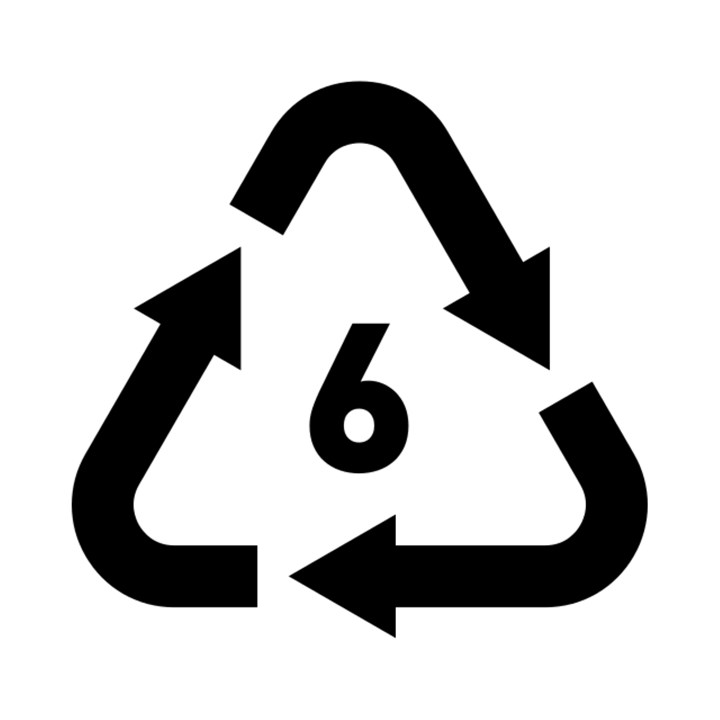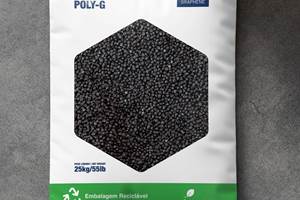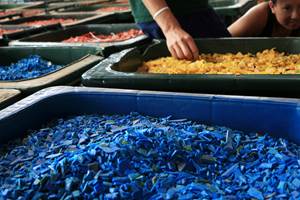FTC Panels Discuss the Green Guides, Recyclability, and Consumer Perception
Public feedback is being solicited on the definition of recyclable and other issues associated with marketing claims.
In December, the FTC announced it would seek public comments on potential revision to the Guides for the Use of Environmental Marketing Claims, also known as the “green guides”, which were last updated in 2012. The guides advise marketers on how to avoid running afoul of the Federal Trade Commission Act, 15 USC 45, which prohibits ''unfair or deceptive acts or practices in or affecting commerce. ''
The guidance covers general environmental claims and several specific claims. Among those likely to be of interest to plastic manufacturers are: compostable, degradable, free-of, and — of course — recyclable and recycled content. On May 23rd the FTC hosted a workshop to discuss marketing claims around recyclability.

The commonly used symbol for PS, a theoretically and technically but not practically nor economically recyclable material. Many have expressed concern that incorporation of the chasing arrows symbol misleads consumers by implying recyclability.
Photo Credit: Public Domain
James Kohm, associate director at the FTC Bureau of Consumer Protection, opened the event by describing the mandate of the FTC, not to set environmental policy but to prevent consumer deception by marketing claims. “The green guides are the FTC’s interpretation of Section 5, which prohibits deceptive advertising. Deceptive claims look not to the definition of the claim, but how reasonable consumers interpret that claim,” says Kohm.
Marketing Claims and Recycling Realities
Panelists provided the moderators, FTC attorneys Hampton Newsome and Julia Solomon Ensor, with their views on the current state of recycling and of current recyclability marketing claims.
Public enthusiasm for recycling remains high, and is motivated by a broader desire for sustainability. “People are really trying to do their part in helping the environment and they want to buy earth friendly, sustainable products and are willing to pay more for them,” said Bonnie Patten, executive director at Truth in Advertising, a nonprofit consumer advocacy group. Dr. Quinta Warren, associate director of sustainability policy at Consumer Reports, shared that 70% of consumers recycle at least often. “We are already in a good place because we don’t have to convince consumers to recycle, our surveys show they already want to,” says Warren.
This trend has encouraged brands to align their marketing claims with this enthusiasm. Marketers can make qualified or unqualified claims of recyclability. “Check Locally” is an example of a common qualification of a marketing claim, an unqualified claim would simply say “recyclable”.
Currently the green guides advise marketers to avoid making an unqualified claim of recyclability unless 60% of the consumers to whom it is marketed have access to recycling for that product.
Anne Germain, COO at the National Waste and Recycling Association, says that the organization’s members are still reporting contamination rates as high as 20%, and attributed this to misunderstandings about what is accepted by recycling programs. “We do think labeling has a significant impact on that contamination and perception,” says Germain. Germain described some of the biggest problems faced by MRFs are caused by plastic films, which foul up machinery and cause frequent shut downs; and lithium batteries, which are causing an alarming and steadily increasing number of fires in recycling facilities.
Discussion zeroed in on plastics as an area of wide variation between localities and potential misinterpretation. “Plastics are where we get 98% of the confusion,” says Adam Reidel, manager at the Environmental Management Office for Arlington County, VA.
Collection is generally strong where corresponding end markets are strong, such as for PET bottles, but there is variation in how lower value materials are handled. Arlington County, for instance, collects resin codes 3, 4, 6, and 7 although Reidel expressed doubt that these materials were being reprocessed.
Forty million Americans have no curbside collection at all, according to comments from Kate Bailey, chief policy officer at the Association of Plastic Recyclers. But that could change. “There has never been more momentum to improve recycling, and in particular plastics recycling, than we are seeing right now,” says Bailey.
Consumer Perceptions of Recyclable Claims
“Our research shows that what people trust and how they trust the interpretation of claims directly impacts whether or not they choose to recycle.” says Sarah Dearman, chief innovation officer at the Recycling Partnership. Dearman argued that smart, qualified claims would balance the need to for transparency while still enabling a pathway for packaging that is making steady progress toward recyclability.
Panelists were asked to consider what unqualified recyclable claims mean to customers.“When people see a recycling symbol or message on a package, they expect that it is going to be made into something new,” says Dearman, “our research shows that over and over.”
Karen Hagerman, director of the How2Recycle program at GreenBlue, described survey results on the spectrum from theoretical recyclability to 100% actually recycled. “We found the most agreement in the category that the thing is recycled most of the time, but not always. We found this to be encouraging as it is in alignment with the definition set forth in the green guides,” says Hagerman.
Do Chasing Arrows Imply a Recyclability Claim?
Several panelists pointed to current implementation of resin identification codes as a source of confusion. Usually, the resin codes are surrounded by the chasing arrows symbol. “The chasing arrows mean recycling everywhere else except with plastic,” says Anne Germain. According to Peter Blair, policy director at Just Zero, only 8% of survey respondents understood that the resin code was not a guarantee of recyclability.
ASTM changed its standard for the use of resin identification codes in 2013 for this very reason, replacing the arrows with an unbroken triangle. However, adoption of the new design has been challenged. Many state laws mandate the use of the chasing arrows symbol. California has adopted new legislation requiring a disclaimer when the chasing arrows appear on plastic packaging that is not “recyclable” according to standards set by the state.
Future of the Green Guides
Panelists also were asked to consider how the FTC can, within its current authority, help resolve issues with customer deception in recyclability claims. Responses varied. “The onus of sorting through green claims should not fall on consumers,” says Dr. Quinta Warren, “We need the FTC to set clear guidelines that corporations have to follow, but also that consumers can use.”
Raissa Lerner, deputy attorney general in the State of California, cited recent cases where courts had interpreted recyclable claims as indicating only technical recyclability. “Maybe it could be made more explicit that we are talking about the end user, not just putting it in the bin but all the way through, because the consumer expectation: that they are the beginning of that process.”
Patrick Krieger, vice president for sustainability at the Plastics industry association, drew a distinction between demonstrating the capability of recycling, and demonstrating that something is actually being recycled. “The term recyclable, and especially when we use it in an unqualified way, is that you have the ability to and not is actually (recycled),” says Krieger, “You do have to be able to make it into a finished product again, but that is different from ‘must’ because of many economic considerations outside of the producers’ control”.
Peter DePasquale, VP of government affairs for Kuerig Dr. Pepper, suggested design for recyclability as a consideration. “We have MRFs and recyclers who say they want products and packages in a certain way so there can be an end market, and I think part of the analysis should be if that design for recyclability is adhering to well-recognized design guides.”
More Opportunities to be Heard
The FTC is seeking additional public comment, which will be accepted until June 13, 2023. Instruction for submitting comment can be found on regulations.gov. The EPA is also seeking public comment, on its National Strategy to Prevent Plastic Pollution. Comments are due June 16, 2023.
Related Content
‘Monomaterial’ Trend in Packaging and Beyond Will Only Thrive
In terms of sustainability measures, monomaterial structures are already making good headway and will evolve even further.
Read MoreGeneral Polymers Thermoplastics to Further Expand Distribution Business
NPE2024: Following the company’s recent partnership buyout, new North American geographic territories are in its sight.
Read MoreGerdau Graphene Launches “First” Graphene-Enhanced PE Additive Masterbatch for Extruded Packaging and More
The company has also partnered with conglomerate Sumitomo Corp. for distribution of its graphene-enhanced masterbatches in Japan.
Read MoreAt NPE2024, Follow These Megatrends in Materials and Additives
Offerings range from recycled, biobased, biodegradable and monomaterial structures that enhance recyclability to additives that are more efficient, sustainable and safer to use.
Read MoreRead Next
Lead the Conversation, Change the Conversation
Coverage of single-use plastics can be both misleading and demoralizing. Here are 10 tips for changing the perception of the plastics industry at your company and in your community.
Read MoreSee Recyclers Close the Loop on Trade Show Production Scrap at NPE2024
A collaboration between show organizer PLASTICS, recycler CPR and size reduction experts WEIMA and Conair recovered and recycled all production scrap at NPE2024.
Read MoreBeyond Prototypes: 8 Ways the Plastics Industry Is Using 3D Printing
Plastics processors are finding applications for 3D printing around the plant and across the supply chain. Here are 8 examples to look for at NPE2024.
Read More






























